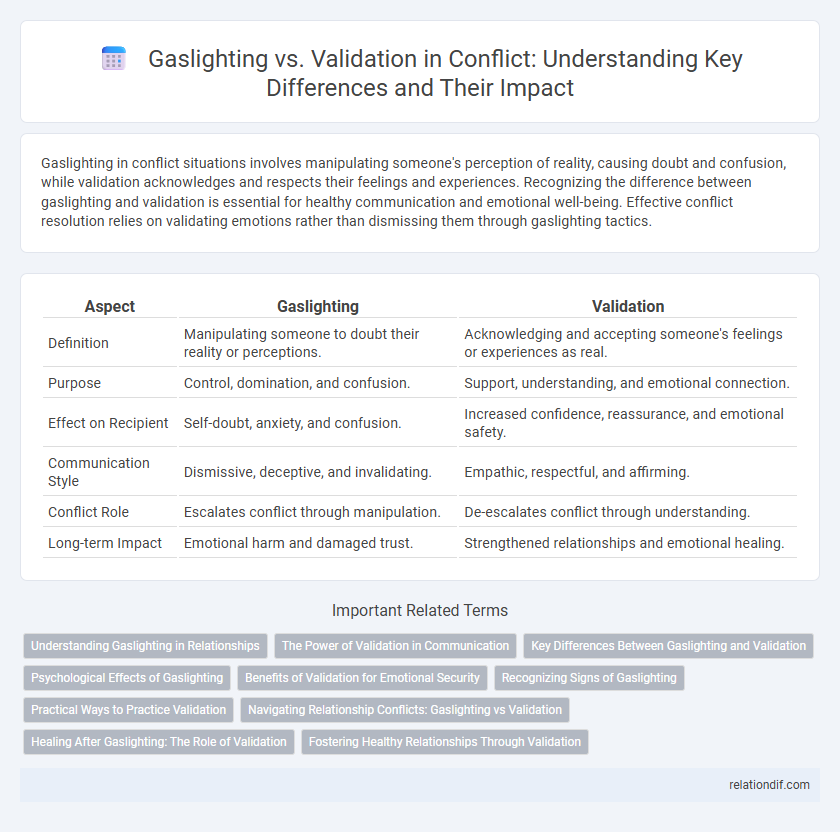Gaslighting in conflict situations involves manipulating someone's perception of reality, causing doubt and confusion, while validation acknowledges and respects their feelings and experiences. Recognizing the difference between gaslighting and validation is essential for healthy communication and emotional well-being. Effective conflict resolution relies on validating emotions rather than dismissing them through gaslighting tactics.
Table of Comparison
| Aspect | Gaslighting | Validation |
|---|---|---|
| Definition | Manipulating someone to doubt their reality or perceptions. | Acknowledging and accepting someone's feelings or experiences as real. |
| Purpose | Control, domination, and confusion. | Support, understanding, and emotional connection. |
| Effect on Recipient | Self-doubt, anxiety, and confusion. | Increased confidence, reassurance, and emotional safety. |
| Communication Style | Dismissive, deceptive, and invalidating. | Empathic, respectful, and affirming. |
| Conflict Role | Escalates conflict through manipulation. | De-escalates conflict through understanding. |
| Long-term Impact | Emotional harm and damaged trust. | Strengthened relationships and emotional healing. |
Understanding Gaslighting in Relationships
Gaslighting in relationships is a manipulative tactic where one partner distorts reality to make the other doubt their perception and sanity. This psychological abuse undermines trust, causing confusion and emotional insecurity. Recognizing signs of gaslighting is crucial for maintaining mental health and establishing healthy communication patterns.
The Power of Validation in Communication
Validation in communication fosters trust and reduces conflict by acknowledging emotions and perspectives, promoting understanding and empathy. Unlike gaslighting, which manipulates reality and undermines self-trust, validation empowers individuals to express their experiences authentically. Effective validation strengthens relationships and encourages constructive dialogue, essential for conflict resolution and emotional well-being.
Key Differences Between Gaslighting and Validation
Gaslighting distorts reality by causing victims to doubt their perceptions and memories, whereas validation acknowledges and affirms an individual's feelings and experiences as genuine. Gaslighting undermines trust and fosters confusion, while validation builds empathy and strengthens communication. The key difference lies in intent: gaslighting manipulates to control, validation supports emotional clarity and understanding.
Psychological Effects of Gaslighting
Gaslighting inflicts severe psychological effects by systematically undermining a person's perception of reality, leading to confusion, self-doubt, and anxiety. Victims often experience diminished self-esteem and increased dependency on the abuser, resulting in emotional distress and impaired decision-making. This manipulation contrasts sharply with validation, which promotes mental well-being by affirming an individual's feelings and experiences.
Benefits of Validation for Emotional Security
Validation enhances emotional security by acknowledging and affirming an individual's feelings, which fosters trust and reduces anxiety. Unlike gaslighting, which distorts reality and undermines self-confidence, validation promotes open communication and strengthens relationships. Consistent validation supports mental well-being by creating a safe environment where emotions are respected and understood.
Recognizing Signs of Gaslighting
Recognizing signs of gaslighting involves identifying persistent manipulation tactics such as denying facts, twisting information, and causing self-doubt to control or undermine someone's perception of reality. Victims may experience confusion, anxiety, and decreased self-esteem as they question their memories and judgments. Awareness of these behavioral patterns is crucial for distinguishing gaslighting from healthy validation, which supports and affirms an individual's feelings and experiences.
Practical Ways to Practice Validation
Practicing validation in conflict involves actively listening to the other person's perspective without judgment and acknowledging their feelings as legitimate. Using empathetic statements such as "I understand that this situation is upsetting for you" helps to build trust and reduce defensiveness. Consistently reflecting back what the other person is expressing ensures they feel heard, contrasting gaslighting, which denies or distorts their reality.
Navigating Relationship Conflicts: Gaslighting vs Validation
Navigating relationship conflicts requires distinguishing gaslighting, a manipulation tactic that distorts reality and undermines trust, from validation, which acknowledges and respects feelings. Recognizing gaslighting signs, such as denial of facts and shifting blame, empowers individuals to maintain emotional clarity and protect their well-being. Fostering validation promotes open communication, strengthens emotional bonds, and facilitates conflict resolution.
Healing After Gaslighting: The Role of Validation
Healing after gaslighting requires acknowledgment of the victim's reality to rebuild trust and self-worth. Validation from trusted individuals or therapists reinforces the survivor's perceptions and counters the manipulative distortions of gaslighting. Consistent validation fosters emotional recovery, empowering victims to reclaim their autonomy and establish healthy boundaries.
Fostering Healthy Relationships Through Validation
Validation in conflicts involves acknowledging and affirming another person's feelings and experiences, which fosters trust and emotional safety. Gaslighting, on the other hand, undermines reality and erodes self-esteem by denying or distorting someone's perception, leading to confusion and alienation. Prioritizing validation promotes open communication and mutual respect, essential components for building and maintaining healthy relationships.
Gaslighting vs Validation Infographic

 relationdif.com
relationdif.com